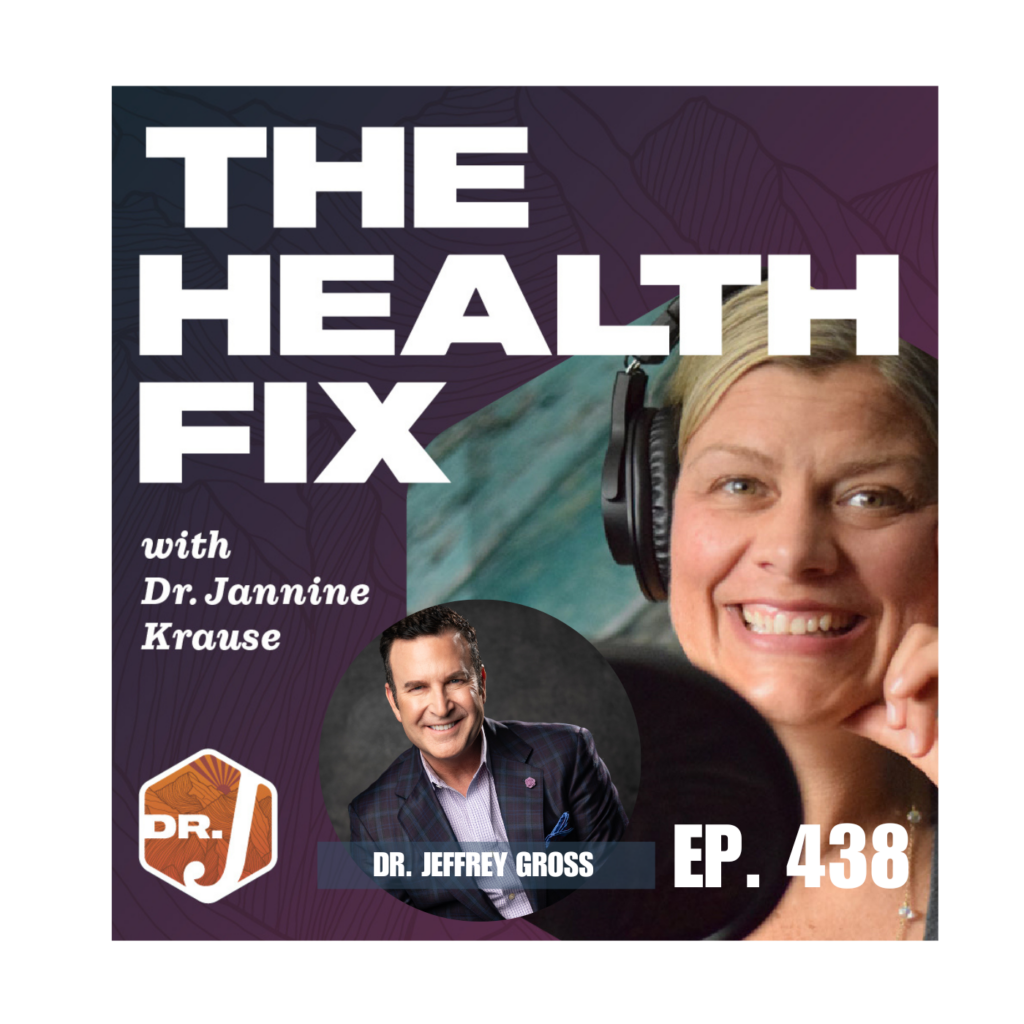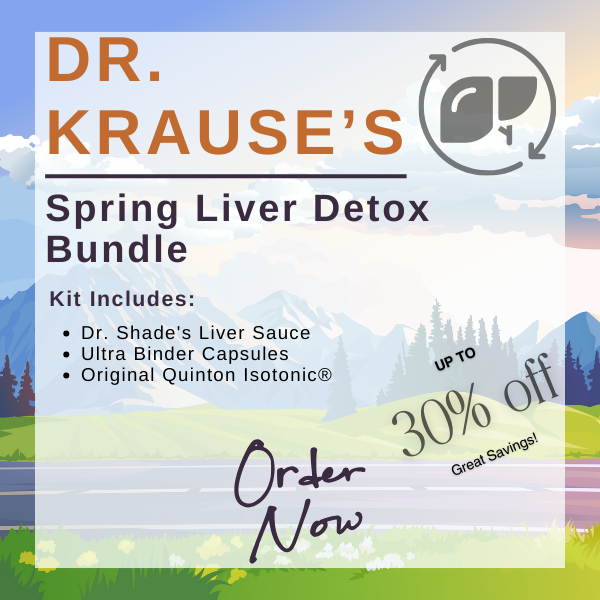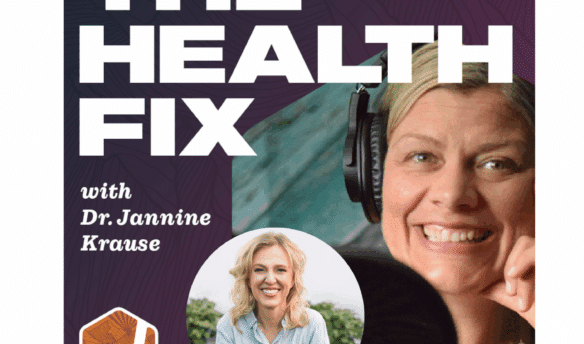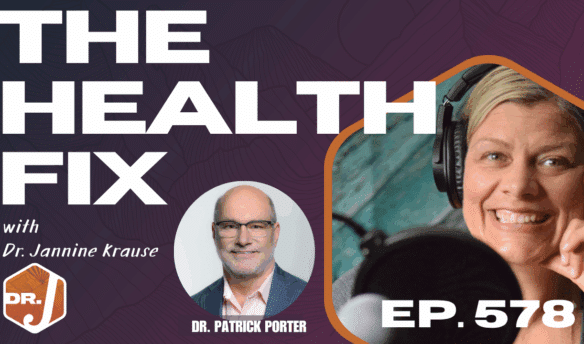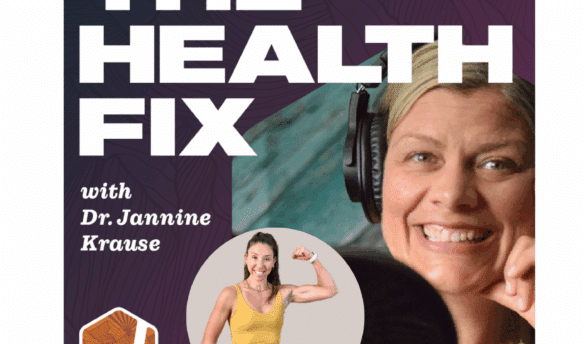Ever wonder what doctor’s look at on MRIs of the spine? Curious about what regenerative medicine docs are thinking when the evaluate your spine for stem cell, exosomes or platelet rich plasma? Dr. Jeffrey Gross is a spine fellowship trained neurological surgeon and founder of “ReCELLebrate” a regenerative medicine clinic in Henderson, Nevada. He’s passionate about helping clients rejuvenate their health by offering precision medical, longevity, and biohacking consultations to reduce disease and improve health-span. In this episode of The Health Fix Podcast, Dr. Jeffrey Gross reviews Dr. Jannine Krause’s low back MRI and talks about disc herniation, nerve compression and what he’s doing to regenerate spines. *Note – for a richer podcast experience check this podcast out on Youtube, link below.
Dr. Krause’s Protocols
Instructions Included
Traveling soon? Looking to detox or reset your gut? Try one of Dr. Krause’s Fullscript plans.
What You’ll Learn In This Episode:
- What MRIs can tell you about your body
- How certain types of MRIs can help doctor’s visualize the bone marrow
- Why things that show up on MRIs may not be the cause of your pain
- How the term “degenerative disc disease” is not a disease – it’s degeneration of the spine from age or an injury
- The health of your spinal vertebrae dictates the health of your discs
- How stem cells, exosomes and platelet rich plasma are being used for spinal rejuvenation
- Preventing joint replacement surgeries with advanced therapies
Resources From The Show:
- Dr Gross’s Website – ReCellebrate
- Watch this episode on Youtube – Click HERE
Our Partners
Podcast Transcript
3:42 – A little bit about MRI’s
10:56 – Going over Dr. Krause’s recent MRI visit / typical questioning of a patient MRI review
36:43 – Tips if patients are having a lot of pain
40:23 – How to treat a herniated disc
44:23 – Regenerative medicine
50:01 – Treatment plan for Dr. Krause’s back
JANNINE: [Intro] Welcome to the Health Fix Podcast, where health junkies get their weekly
fix of tips, tools and techniques to have limitless energy, sharp minds and fit
physiques for life.
Hey health junkies, on this episode of the Health Fix Podcast, I have Dr. Jeffrey
Gross back on. He’s a spine fellowship trained neurological surgeon and founder
of ReCELLebrate, a regenerative medicine clinic in Henderson, Nevada.
And today, we’re going to be talking about the MRI that I had on my spine and some of
our findings.
Why do we want to do that?
Why am I sharing that?
Because Dr. Gross has some amazing ways that he is rejuvenating folks’ spines.
So if you’ve been told you have degenerative disc disease or degenerative changes, there
may be ways to regenerate your spine and help you get rid of some pain, but also just feel
like a million bucks.
So Dr. Gross and I in this podcast are going to go through my MRI.
We try our best to be able to make this a podcast that is visual as much as it is audio.
But if you’re really wanting to see the best version of this podcast, head over to my YouTube.
It’s DocJKrauseTV.
And you’ll have a great view of what’s going on if you want to see those images.
So let’s get on with the podcast.
– Hey, health junkies.
So I brought Dr. Jeffrey Gross back on to talk about my MRI
’cause we did an MRI because I was telling him a little bit
about my back pain that was going down to my foot
and it was causing a ton of issues for me.
And I like lifting heavy weights and I was like,
Man, I really need to know.
Am I doing myself, you know, a disservice here or what?”
So Dr. Gross, welcome to The Health Fix Podcast once again.
JEFF: Thank you.
JANNINE: I’m excited to talk about my back.
And so we have the imaging here.
folks, of course, we did a little bit of a trial run before this in a parking lot
outside of a, I’m telling you guys, it was a Wendy’s in Milwaukee, because I didn’t
have anywhere else to stop.
So there you have it.
Did I go get a frosty?
I wish.
No, I, I, after my back, after we learned about the back, I was like, I’m just going
to go home now.
So that’s the preview to it.
So Dr.
Gross kind of break it down in terms of the things you were asking me about my
pain so that you kind of can give folks a sense of why you would do an MRI, why we thought it was
a good idea to run straight to that because a lot of docs, you know, unfortunately insurance-wise,
we have to jump through hoops normally. But if we decide to do cash pay, MRIs, we could do whatever
we want. So give us the scoop as to why we would want to do an MRI in my case.
JEFF: Well, an MRI is a wonderful imaging tool ahead of its time that helps us see a lot of things that
we cannot see on x-rays and CAT scans. And although there are needs at times for x-rays
and CAT scans and maybe even some other tests, MRI is probably your best yield for looking
at common ailments, problem symptoms stemming from the spine. So when you told me about
your symptoms, which we’ll get into here in a moment, an MRI was the most useful thing
I could think of to help us correlate or figure out why you have those symptoms.
JANNINE: Mm-hmm. Mm-hmm. Makes sense. Makes sense. And in particular, you had me seek out a specific
medical imaging place. I had a specific type of MRI because you’ve looked at some of my other
patients on MRI’s and you’re like, Oh, these MRI’s aren’t as detailed. Give us that keyword
that folks want to be looking for and asking their docs for a really good quality MRI.
JEFF: Yeah, let me explain a little bit about MRIs because most patients don’t know and most
doctors don’t even know when they’re ordering them and when they get the results back it’s
just a written report.
Very few people look at the pictures unless you’re a spine specialist like me or the radiologist
and people don’t know the difference, most docs don’t.
So first of all, like anything you do, the better quality the image, the more you might
find when you’re looking to find something.
So and MRIs have grown up since they’ve been around in the 1980s, and they’ve grown up
in improvement and quality, and that comes from something called signal-to-noise ratio.
We want more signal and less noise.
Okay.
It’s like a radio, a static radio signal for those of us that remember listening to the
actual radio. You know, you want less static and more high fidelity sound coming through.
And then a number of years ago, they came up with high definition radio. Remember that?
So what’s the difference between regular and high definition? More signal less noise.
So the latest greatest MRI that you can get routinely in the community, in most communities,
is called a three Tesla MRI three Tesla. Tesla stands for the magnetic strength name for
you know professor Tesla who you know was at one of the leading authorities on magnetic
electromagnetic electromagnetism years ago. So now the commonly in the community you’ll find 1.5
Tesla and if you are at an orthopedic doctor’s office and they say oh we have an MRI here in the
office, it’s usually 0.3 or 0.5. But wait, there’s more. It’s not just the linear relation
of those numbers, meaning if you go for a one Tesla and I want you to have a three Tesla,
the three Tesla is not three times better. Because the magnetic strength field in the
signal equation, the signal to noise calculation, is by its square. So if a three Tesla magnet
is three squared compared to a one Tesla, which is one squared.
So that’s a nine times difference.
So there are other factors besides the magnetic strength, by the way,
there are software gradients and sequences I want to get into in a second.
But now everyone will have a PhD after watching your podcast.
The, you know, they charge the same generally to the insurance company
because the CPT code is the same.
So why get the crappy one where you can get a good one and the better the picture,
the more the doctor can do with it, just like if you want to buy a new television and you went
to Costco and you said, oh, I can get this, this 4K ultra HD plasma screen here.
It’s the cost of come way down compared to an old staticky tube TV.
Right? So that’s what we’re looking at.
generally speaking, there are other factors that go into signal to noise. Now, when you get an MRI,
you get a number of sequences, and they’re different techniques. And that’s why you’re in
that machine for anywhere from 15 to 30 minutes, because they’re doing multiple sequences. A sequence
is a bunch of slices. And those sequences look at different things. Commonly, you get T1 and T2,
which stand for time one and time two. And that determines when they pick up the signal and what
type of fluids and chemicals they’re looking at. Because yes, we’re looking at biochemicals,
we’re looking at water and protons. But there’s a fancy one that I look at, and I have to order it
especially because most places are cheap and dirty and don’t want to include it. And it’s
called inversion recovery when we’re looking at the spine. It’s actually STIR, I think,
a short T inversion recovery and we call it stir or IR and those images help me look at the bone marrow
and because I do regenerative medicine the bone marrow is often my target so I’m looking at very
specific changes in the bone marrow so that was probably way too much but hope someone liked it.
JANNINE: It’s great because like for us it’s imaginary right you’re like okay MRI they’re going to stick
mean it to but it’s going to suck. That’s kind of what most people equate to MRI. But I don’t think
a lot of folks really understand what’s happening in that and that we’re actually looking, you know,
what we’re looking for and how.
JEFF: Right. So, you know, we’re lucky to have MRIs, you know, because
when I was, when I was training, you know, there was only one MRI was in the hospital, you know,
not everyone got an MRI because it wasn’t enough to go around. So I still trained in an era where
we had to listen to patients and examine them. And I want to be clear that we don’t treat the MRIs,
we treat the patient. And if for any reason you see a physician and the physician doesn’t examine
you and spends a minute with you and just pops up the MRI and looks at it or tells you what’s on
it and that’s what they’re addressing, run away. Because the MRI may not, we see things
that may not be the cause of the pain at all.
JANNINE: Right.
JEFF: Yeah.
So anyway.
JANNINE: No, that’s huge to talk about.
And one of the things that, you know, in my head,
I always before I run an MRI and folks,
I always will warn them that like,
we may see something, it may correlate, it may not.
We may find really random things
like one of the things we found in my mid-back that–
JEFF: Right.
JANNINE: Who knows?
JEFF: Right.
JANNINE: Yeah, yeah.
So let’s see what you got on me
and whatever questions you want,
you were gonna ask me because I know that for you,
there’s a certain sequence when you look at MRIs,
you ask folks certain things.
And guys, he asked me a million questions more
than anyone’s ever asked me about my back.
So, and my pain and legs.
So, well, have you just run through it?
Just like…
JEFF: All right, you pretend.
We’ll pretend we never did it before?
JANNINE: Yeah, exactly.
JEFF: So do you remember in the ’90s,
there’s a show called NipTuck?
JANNINE: Yes. – Yes.
JEFF: So the two plastic surgeons would sit down
and a new patient would come in
and have you liked the start of the show.
And they would say, tell us what you don’t like about yourself.
And I thought it was brilliant because you know,
I’ve seen thousands and thousands of patients as you have.
And you know, some come in and tell you exactly what’s wrong.
Some come in and say, I’m here, figure me out.
you know, and there’s a lot in between.
So I’d like to start out with,
tell me what your problem is, what your symptoms are.
And sometimes I have to help people describe them there.
Some people are just not good descriptors
of their symptoms.
Oh, I have soreness.
Well, is that pain?
Some people don’t like to use the word pain, for example.
Others will say, oh, I’m dying.
And well, what’s causing you to die?
You know, give me more.
So I would say to you, tell me exactly what you have,
where you have it.
And I’ll ask you questions to, to, you know,
bring out some flowery information about it.
So, okay, so we’ll, we’ll, we’ll, we’ll play here.
I’ll be the doctor.
He’ll be the patient in this, in this podcast.
Where is your pain?
JANNINE: My pain’s in my low back and my right side joint.
And more than anything, it’s in the right side joint.
JEFF: Okay, so you, you already gave me more than most people
because you know anatomy and you know some stuff.
So most people will come and say, “I have low back pain.”
And I would look at them and say, “Great.
Can you please stand up, turn around,
and point to where in your low back?”
‘Cause the low back is this big, right?
It’s, you know, it’s like two feet across
and it could be depending on what you call the low back.
And some people are afraid to say, “buttock,”
and it might include their butt and whatever.
And, or, or something else.
So, so you said low back.
So I would start with, does the low back component,
’cause I’m breaking it down,
does that come from the midline
the spine might be.
JANNINE: Yes, it does.
JEFF: Yeah. Okay. And then I’d ask you a point to where that is or
tell me is it at your belt line? If we’re telemedicine, I, you know, instead of showing me on it,
say is it tell me, tell me by relation to your belt line or your waist. JANNINE: It’s below my belly button
and like literally a little bit below if I put my hands on my hips and I brought my fingers around,
it’s a little below there.
JEFF: So that tells me it’s probably in the L4, L5 region, maybe lower.
The waistline is commonly known to be associated with crossing through the disc between the fourth
and fifth lumbar bones. So we count those one through five starting below the last rib,
going down to the tailbone. All one is lumbar one, two, three, four, five. The discs are numbered in
between, which is a very funny thing, because you hear of it, the L34 disc. It’s the L3-4.
It’s like you live on Maple Street, you live at 8 Maple Street, someone else lives at 10 Maple
Street, but the yard in between is 8 to 10 Maple Street. And that’s what we’re talking about here.
So the waist is probably around the L4-5 disc area. So that gives me some idea already where
to look, you know? Okay, so we know you have low back pain. I might ask you more questions
like what sets it off, what makes it feel better, like, you know, positioning, bending,
and then, and then you said it goes into the SI joint, which SI joint did you say?
The right one. Okay. Does it ever go to the left side?
Nope. Always the right.
Does it travel from the lower back spinal area to the SI joint or is the SI joint separate?
No, it travels.
Okay. And for the listeners, uh, that they don’t know the SI joint is some people don’t come in
and say, my side, but it’s a spot above the right butt cheek in the lower back that’s probably
three or so inches to the either side, but in your case, hurts on the right side.
And then I would ask questions about that. So does that is that pain any different than the spinal
pain?
JANNINE: Yes. Sometimes I will, I will barely feel the spinal pain, but I feel the
the throbbing at the right SI joint happening all the time.
JEFF: Okay. Does that, does that, we’ll call it the SI joint pain?
Cause we’ve named it that does, and that stands for sacroiliac joint.
It’s where the pelvis meets the sacrum of the spine.
Uh, does that pain, um, radiate or move anywhere?
Does it go down?
Does it go up?
Does it go sideways?
JANNINE: It’ll go all the way down to my foot and the bottom of my foot.
JEFF: Okay.
So a lot of people say the all the way down phrase and then I stopped and say,
Show me the Google Maps.
How does it travel all the way down?
That’s a good one on the front of the thigh,
the back of the thigh, ’cause now I’m thinking nerves
and I wanna know what nerves might be involved.
– All the way on the right, so right lateral.
So on the side of my thigh, on the side of my low leg,
and then it seems to go like behind my ankle,
wraps around, boom, to bottom of the foot.
JEFF: Does it involve any toes?
JANNINE: Yes, yes, it does.
In particular, my third toe is a problem.
And so it was my second sometimes.
JEFF: Okay, so that helps us,
the further down it goes in the leg and foot,
and the more we know about the toes,
the better we can discern or guess which nerves are involved.
So that gives us some ideas.
Okay, so that tells me L5 and/or S1 nerves,
and then we can track those nerves
potentially back up to the spine,
but those nerves also pass by the sacroiliac joint
and can be irritated there as well.
So we have this complexity, right?
We have like two crimps in the wire
and we have to figure out which one is causing it,
or both, right?
‘Cause that’s an option.
JANNINE: Yep.
JEFF: Okay, so any weakness?
JANNINE: Yes, I will sometimes have the foot,
doesn’t want to come along with me.
I don’t have foot drop and so folks, foot drops,
like I can’t actually move my foot.
My foot’s will move, it just doesn’t want to.
Sometimes I kind of tend towards dragging my leg
behind me, so I’ll limp.
I have a good gangster limp, is what happens.
JEFF: Okay, awesome, but not on purpose.
JANNINE: Not on purpose, no.
JEFF: And the weakness you have is in lifting the foot,
even though you don’t have a full on foot drop.
JANNINE: Right, right.
JEFF: Some patients will say their doctor said that in foot drop
’cause they have just a little bit of weakness.
But truly you’re right, foot drops
and you can’t lift that foot at all.
So you have weakness in what we call the dorsiflexion
or the lifting function of the foot,
and that’s commonly related to the L5 nerve also.
So there are motor or movement functions.
That’s the movement function.
Then there are pain and sensory functions.
Do you have any numbness?
JANNINE: Yes, sometimes that fourth toe
will get numb third and fourth.
Between the two, they kind of battle back and forth.
JEFF: Okay.
So we have a lot of indicators for L5 nerve,
maybe spreading into the S1 nerve.
But so I have a good idea where things are coming and going.
And I could ask a lot more questions than I might,
but for the purposes of this podcast,
we have a sense of your pain and your nerve involvement.
Some people don’t have nerve involvement.
Some people have nerve involvement without pain.
So if it were so perfect, chat GPT could do this,
but probably we’ll get better at it.
But okay, so this is where I would examine you.
And now because we do a lot of telehealth these days
that’s difficult.
So I have to ask more questions to compensate
for the lack of an exam, right?
And if I were to examine, if you were here in the office
or I were at Wendy’s with you, getting a frosty,
but just the little kid’s size, I think that’s okay.
You can, you can, you know, I would test the strength.
I’d have you push down, push off.
We would test all the muscles of your leg.
We do both legs for comparison.
I would test sensation to sharp touch, light touch.
maybe we also can do vibration and position sense.
We want to get fancy.
And as we do sometimes, if we’re looking for something else,
there are some provocative tests of the SI joint.
Provocative in this case means we want to stress it
to see if we can bring back the pain for a second.
Sorry, but sometimes you have to break a few eggs
to make an omelet.
And then I would have you do range of motion with your back.
I would palpate, meaning lay my hands on your back
and gently touch different things
and see if I can poke and prod
and see if you have some tender spots.
And there’s some art to that as well.
And if your doctor hasn’t examined you that way,
then they’re only treating the MRI.
And I’ve seen a myriad of patients
that have come to me having had surgery somewhere
where the doctor only looked at the MRI,
treated something they saw on the MRI,
but it wasn’t the problem, the patient’s still suffering.
So that is a popular thing in this day’s
quick cookbook, insurance driven, crappy medicine world.
There I said it.
JANNINE: It’s okay, that’s why you’re here.
That’s why we’re talking about it.
JEFF: I hope so.
I’m here to support the right way.
Okay, so then we look at the MRI.
You ready?
JANNINE: Let’s do it, let’s do it.
I think everyone’s like, let’s see how bad was it.
JEFF: Okay, so I’m sharing screen.
Let me know when it pops up on your side.
JANNINE: We’ve got it.
JEFF: All right, now, of course, you know,
we didn’t say this at the outset,
but you gave me permission to share all your private–
JANNINE: Yes.
JEFF: Your publicly sharing this for the benefit of all.
JANNINE: Yes.
JEFF: So I already brought up the MRI here
and I have on the left screen a side view of the lower back
and on the right screen a cross-section view
of the lower back.
And this is a common way for me to look at it.
very quickly for orientation, I can see it has your name,
has your birthday, so everyone can send you a birthday card.
JANNINE: Yes.
JEFF: And then this was done, you can see that it says
three T up here in the right upper hand corner.
And at the top, I have my different sequences.
So this is a localizer, this is an FR T2,
basically has some other techniques with it.
T1, side view, fast fin echo.
Here’s my stir I was talking about.
And then I have two angled.
They didn’t give me an angled stir and that’s okay.
I can live without it, but you know,
different places will do different things
as long as I get these different sequences, I’m happy.
So we have some side views and cross-section views.
So the side view is if I were standing
to your left, Janine, I would be looking
through your body, through the side of you.
And this is what I would see from your last rib,
down to your butt, okay.
Just from there to there, that’s all that is.
We can’t look above, we can’t look below.
They didn’t do that, they focused in on this.
This line here is the skin on your back and your butt.
And this dark area are your guts,
but they darken them out to improve the contrast
and visualization of the tissues in your lower back.
JANNINE: Nice.
JEFF: So you can see the bones of your lower back now,
these squared or rectangle things.
I’m gonna lighten the image up a little bit,
just ’cause I don’t know how it transfers to your side,
but–
JANNINE: That looks better.
JEFF: That’s pretty stark, okay.
So you can see the gray in the bones.
These are the vertebrae, or vertebral vertebrae.
And then in between the bones are the cartilage discs, okay?
And this is the last, top of the last bone called the sacrum.
And the sacrum is part of the pelvis and part of the spine.
And the side of the sacrum is where you form
the sacrum iliac joint.
Now, we’re really not gonna see that much here
on these images, but you can see the top of the sacrum,
this little thing that looks like a mini disc
isn’t a functional disc.
It’s a leftover vestigial disc
that when animals have tails, they have more segments,
but they’re all fused together to be the sacrum.
It looks like they’re separate, but they’re not.
And this curve in your lower back is actually a good curve.
That’s called the lordotic curve of the lower back.
It’s part of what makes up a normal anatomy.
And if you don’t have this, there are many reasons for it,
but it could become a problem.
So a lot of chiropractors will say, hey,
we’ve got to get your curve back.
and in part, they’re correct,
but that’s only part of the story, okay?
JANNINE: Wow.
JEFF: Now, these are some of the bones
that stick out in your lower back.
If you bend forward and you see those bones
stick out in the midline,
these are those little bones
because when you look at the bones of the spine,
they form a ring and that ring is designed
to protect this canal or form this canal
where the white and the gray strands are.
And that is your spinal canal.
And all the way from your brain down
to about the L12 junction is this gray spinal cord.
But the vast majority of your lower back or lumbar spine
has no spinal cord in it.
People don’t understand that.
So I wanna make it clear the spinal cord
ends at about the L1-2 junction going down,
counting down from L1, L2, L3, L4, L5, okay?
below there, though, you have nerve branches.
And although it looks like one big nerve here,
these are branches here.
You can see them start to split up here, okay?
So those branches are of the nerve roots
that leave the spine and go down.
And some of them form the sciatic nerve
down the back of the thigh
and then branch out into the different places
down your leg and into the toes
that we talked about earlier.
And as a group, they look like a horse’s tail.
So they’re called the cauda equina, okay?
So over here, we have a cross section.
And what we’re doing is we’re looking up the body.
So if you were lying down in bed
and we were standing at the foot of your bed,
you’re looking at the ceiling, we’re looking at you.
So you’re backwards.
So this is your right side, this is your left side.
And ’cause we’re looking up your body.
This is one of the bones sticking out on the back.
These are your muscles on either side of the spine.
And it, you know, it looks like, you know,
you’re buying a rib roast here at the grocery store, right?
These looks like meat, marble has got marbling in it.
And this is the skin behind there.
Sorry to refer to you like that, but that’s how it is.
JANNINE: No, it’s good for people to know
that that’s what they’re looking at.
I think it’s great.
I also, you know, you had mentioned to me
that you see more marbling a lot of times
folks that don’t have muscles strong is strong of muscles in the back and that’s something too.
JEFF: So this is a very lean piece of meat.
Sometimes we see a lot of fat in there and people who don’t exercise or don’t don’t maintain these
muscles. And there’s a lot of research that shows that the volume of this muscle and its
meaty volume is a good harbinger for your back, meaning you’ll have less pain, less fewer problems
and vice versa. So the strength of your back is important. And these are the main muscles of
your back. They’re on either side of your back, either side of your spine. They go up and down,
like pillars. This particular cross section shows the vertebral bone and shows these little dots.
These dots are your coty-aquina, your nerve roots going down the canal of your spine.
See how it’s protected in there? Now here’s a cool thing. See these yellow dotted lines on the left?
When I scroll the right side, that middle dotted line moves because it’s taking slices
and I can look slice by slice by slice. Okay, so now it’s clear to me that something goes
going on with this disc there’s a white spot and it is I’m going to use this
word then remove it bulging out into the nerve sac you see that but it’s it’s
the definition of bulge is a is a relaxing of the disc more than 50% of
its circumference usually affiliated with age this is not a bulge it is
actually a amount of slipped disc that we call a herniation and it’s contained
by the ligament, so it’s a protrusion form of herniation.
And the white spot is typically an inflammation spot related to a tear because to have a herniation,
there must be a tear in the ring of the disc.
So if we slice right through there, this spot right here is that tear.
And you can see the, I’m going to use this word again, bulging nature of the herniation.
And you can see the nerves are a little bit kind of crowded when you compare it to a spot
above.
They have plenty of room.
So this causes a little area here of narrowing of the nerve pathways.
And that’s, we call that stenosis.
But this stenosis is due to this herniated disc.
So that’s between the L4 and the L5 bone and that could correlate with your symptoms.
But wait, if I’m thorough and I look at the last disc, there is something over here, but
not over here.
Now, remember, this is your right, this is your left.
So you told me that your symptoms go down your right leg and affect the L5 nerve.
And lo and behold, the L5 nerve does pass by here.
And it’s space is taken away from it.
So guess what?
I have a yellow line here.
I can do a slicing through that.
And now on the side view,
we take the side view out to the corner.
And now, which looked normal in the middle,
that L5 S1 bottom disc is now showing itself.
There’s a big honking piece of material
sitting out in what we call the frame in where the nerve travels out. A little bit here, but
here it’s kind of open. You can actually see up at L3-4 this little gray thing, that’s the nerve
coming out your spine to join the sciatic nerve. Here it’s harder to see and here it’s
completely obliterated. So I think the vast majority of your symptoms down your leg at least,
and possibly through your SI joint are coming through because of this L5S1
forraminal herniation of the disc.
JANNINE: Definitely very clear there, very clear.
JEFF: It’s crystal clear.
JANNINE: Yeah, yeah. Ok.
JEFF: I’m going to go over the stir.
This is that special sequence and I’m looking at the bone marrow here.
Now, you can see that herniated disk a little better, right there.
There’s the one at L4-5, but the one at L5-S1 is a doozy, okay?
Here’s the left side at L5-S1.
You can see it’s open, open, open, but it’s not open on the right side.
It’s got that piece in there.
JANNINE: Mm-hmm.
Mm-hmm.
JEFF: But these are open.
This one this one is a little bit of an issue
You can also have L5 nerve root involvement
from the passing L5 nerve root going by here and then exiting here and that that is kind of a
double
Inflammatory issue on the nerve or double compression
JANNINE: And so a lot of times folks are gonna be saying this thing and like all right, so
you mentioned the bone marrow and is my bone marrow good with a stir? Do I have
enough in there? Do I need some boosting of my bone marrow? JEFF: Yeah, so your stir is
quite good. We’re looking for, you know, we’re looking for changes in the bone
marrow that show that it’s not as robustly active and instead it might be
degenerated. And we see that surrounding disc degeneration and you don’t have significant
loss of disc height. You do have a little bit up here. See how this is a regular at the
junction where you’re thoracic spine, where the ribcage is and meets your lumbar spine.
You have some irregularities and some here, which, but the marrow doesn’t look horrible.
right here, there’s this little kind of divot.
We call that a Schmurals node, if you must know.
JANNINE: Oh, I remember that from school.
JEFF: You got a little Schmurals node.
And then you do have some, see, the disc material here is degenerating out in
different spots.
So these are degenerated and I don’t recall.
You said you, you really don’t have, you had some pain at that junction.
Did you not?
And we had to discover this backwards.
I had to ask you about it or–
JANNINE: Yeah cuz the only time it shows up is when someone does a massage
On that side and like they just get to that right point. It’s like I I’m like, I get like a little squirrely on the table
That’s the one spot
Since having the review last time at one of my one my friends had said well
You have larger breasts and she’s like do you think you’re getting pulled forward and some of it’s related to bad
I’m like, oh, I didn’t think about that, but
JEFF: It can be a factor. I mean, it can be a factor. Right? You postural, chronic postural issues,
you know, related to your body or whatever. Of course, you can degenerate things here.
And it’s a junction, a junction of one part of the spine with another where the anatomy changes
is like a fulcrum. So it takes additional stress.
JANNINE: Okay. Okay.
JEFF: Because it goes stress. If you remember physics, it’s a weak point.
JANNINE: Yeah, I could see because obviously we’re rotating at thoracic still,
where lumbar doesn’t quite move as much in that case.
JEFF: So that’s why it’s a junction because it’s a relatively fixed part of the spine,
meshing with a relatively mobile part of the spine.
JANNINE: Things to think about, things to think about. Now, is there
anywhere with my Schmorl’s note and things there, is there anything with exosomes, with PRP, with
anything we could do there to support that disc or even make those disc, not the disc, the vertebrae,
but, and then make those discs happy? I know I’m going to get that question.
JEFF: Well, yeah, there are. I mean, in your case, I wouldn’t, if you only have symptoms during
massage. And this is all I see I probably wouldn’t. It’s not worth it at this point. But your spine
is actually really good compared to most. We see all kinds of degeneration. I see a lot of degenerated
disc complexes, which is the disc has lost some height. It’s lost some of its color. Let me show
you that T2. So, your discs are a little dark here. Hair doesn’t say this disc. It has some
brighter lines in it. So, where’s my gray white? Here it is. There. So, see how this
is kind of a lighter gray here and here and here. And then down here, it’s a little darker.
That darker is some loss of water content or dehydration or what the radiologist called
desiccation, which is just a fancy term for dryness.
So when it starts to lose water, your cartilage gets drier.
Dryer cartilage is more likely to crack, break, and tear, just like an engine gasket.
You replace your gaskets with a nice flexible rubber one after the old one has had all the
temperature changes and cracked and crumbly, it’s just a gasket. So in patients like that,
we start to see marrow changes adjacent to the disc on either side. And those were described by
Dr. Modek, MODIC, M-O-D-I-C out of the Cleveland Clinic, and they’re often referred to as MODIC
changes. You see that word on your MRI report. Now, some radiologists are lazy, and instead of
of describing all that stuff, they’ll just write degenerative disc changes.
JANNINE: I see that often.
JEFF: Which is lazy, lazy, and lazy.
That doesn’t help us.
Of course, we now we have to go back and look at the picture, which is fine.
I look at them anyway, but the reports don’t help anybody these days.
They’re just not very good.
There are some guys, I don’t want to hurt everyone there.
But I mean they should the radiologists should be saying exactly what they see anatomically. They shouldn’t be
Classifying them all under a garbage term and then and to boot they call it a disease degenerative this disease
It’s not really a disease. Come on. If it’s a disease then we’re all doomed
It’s it’s age related degenerative changes or can be related to old trauma also
JANNINE: I’m glad you’re clarifying that say I do get that question too from a lot of patients
Look, oh my gosh. I have a disease in my spine and it’s like no, no, it’s not bad
It’s just age but with age, you know a lot of folks are thinking like, okay, doc
Is there something if I do have these modic changes if I do have Schmorals knows what and and I am having a lot of pain
What would you do?
What would you do in that case? What would you?
JEFF: Well, they’re there, you know, I’m trying not to do surgery unless someone has to have surgery, right? So so
So, things short of surgery, well, first, we start out with the very basics, you know,
physical therapy, weight loss, if it’s something that would help and there’s too much weight,
strengthening of these muscles, these paraspinal muscles, now, yours are fantastic.
I could use yours as an example, right?
You have great muscles, so you’re doing the right stuff here.
JANNINE; I paid him to say that, guys.
No.
JEFF: But you do have great muscles.
So, you know, I mean, there are things we would do there.
Now we also sometimes offer palliative injections called through pain management.
And that’s because sometimes it’s enough just to get someone to feel better, help their
nerves sometimes down their leg and get them walking and exercising again.
It’s not going to cure anything, but it can be a reasonable way to approach something.
Plus, if the situation is complex and I want to know if you’ve got multiple issues in
your spine and I want to know exactly where the pain might be coming from when it’s not
clear, when I correlate your symptoms with the MRI, I can do a test block.
We can inject one area with a little Novocaine type substance and sometimes a little steroid.
And if you felt better in a specific area or a specific nerve distribution down your
like I say, aha, that spot is involved.
It’s like going to the fuse box and flipping one switch
and then yelling inside,
hey, which room do the lights go off in, you know?
JANNINE: Oh, and we’ve done that a couple of times in our house.
JEFF: Yeah, so there’s an approach.
And then usually after, if those things didn’t do enough,
that’s when you’re talking surgery.
But now we have regenerative medicine options
to fill that gap between regular pain management therapy
all the way through surgery.
So now we have a new tool in there that’s before surgery.
JANNINE: That’s huge, that’s huge.
‘Cause I think a lot of people aren’t like,
oh, I really want surgery,
but definitely looking for solutions
or even just like, I think for most people it’s like,
if you can make the pain stop,
I don’t really care how you do it.
(laughs)
JEFF: Sometimes.
JANNINE: That’s how I get it in my office sometimes.
JEFF: No, it’s amazing.
will come in and say my leg is so bad please just cut it off and and they’re they’re being a little
bit facetious but it’s it’s it speaks to how bad it is.
JANNINE: Yeah and that’s that’s the part that you know
kills me and and you know in my case of course I did want to get the MRI because it was starting
to really impede my ability to hike my ability to work you know so you know there are things where
it’s like okay if you have the the knowledge and you know what’s going on then there’s lots lots of
of things you can do. So keep going. Sorry. I interrupt.
JEFF: Oh, no, we’re doing we’re doing
you drive. You tell me where you want to go from here. Well, I think at this point, since we’ve
kind of talked about, you know, my my flap going on, that’s that’s compressing things. I think the
next thing for for folks in general would be all right. So obviously, I don’t have something that
would benefit from say, an injectable of an exosome or stem cell. What kind of case in which
Someone like what would be cases in which you would and how would it look if you can even give us a demo on the screen?
Like what would how would you inject in or like what would you do?
Just because I think a lot of folks are like, okay, PRP’s cool exosomes
I don’t know what they are and what you know give it give us a demo of what you do
JEFF: All right, so let’s say you came in and this is all we saw
Your L5 s1 was beautiful. Your L4 5 has this herniated disc with a tear and
And we saw bone marrow changes here above that disc
and below that disc and the disc was a little flatter.
And it was more degenerated looking and you had pain
and the pain was only centered on the spinal area
and maybe going down the nerve a little bit.
But 90% of your problem was this back pain
and we could correlate it to this degenerated herniated disc.
So patients like this, I target right into the bone area.
I’m pretending you have modic changes in the bone right here and here and why we do that is this disk
isn’t
Super alive. Okay, all the disks. They’re basically biological rubber. They have some cells, but mostly they’re made of squishy proteins
that form the cartilage
And make and make it a cushion make it a
You know a compressive element
but over time that disc is not getting what it needs. And it gets what it needs from the cells
in the bone above and below. And that includes nutrients and includes new proteins. It includes
blood flow because there’s not a lot of blood flow in the disc. It’s mostly the health of the
bone determines the health of the disc, okay? And when you were a fetus, and you were making
that disc in the first place, your bones made it. The cells in what would become your bones
made the disc. In fact, the stem cells made it. And you still retain some stem cells in
your bone marrow. But if your bone marrow is degenerated too and having modic changes,
you’re not able to restore that disk. So we can help people do that. And just, you know,
to make sure everyone’s clear on this, I cannot make any claims because they have not yet been
approved by the FDA. But this is what we do. And this is how we try to achieve the results
based upon some really good science with over a 15 year follow up in France. So we’re just
behind here. Having said that, I would inject exosomes to stimulate and reactivate cellular
activity in your bone marrow. And restore that bone marrow. We call that the sub-condrel bone,
because it’s right next to the cartilage. Condrel is cartilage. And by stimulating both of these
areas, we can jazz up the factory that made that disc in the first place to start making
some factory parts, some proteins, and pump up that disc with some additional cartilage.
And that should restore its function as a shock absorber, and in doing so, the goal
would be to reduce the pain that you have.
May or may not fix this problem, but if this is again, just an incidental finding and you’re suffering from back pain from the degeneration
This is what we do
JANNINE: Nice now, you know, I’m guessing that you see MRI’s on folks where there’s really not any major
herniations like in the case that I have or bulges and you just see disc degeneration Just in and of itself
yeah, and and so those folks I’m imagining like
That’s a very important thing for folks that are, like, I have pain, my doc told me there’s just degenerative disk changes, and there’s nothing they can do.
This is where stem cell and exosomes can come in and be incredibly helpful.
JEFF: Yeah, I mean, it’s fair for decades, there really wasn’t much to do besides your exercise and, you know, fixing the body the best you can.
the use of regenerative medicine does have an application here, it’s, it’s, you know, this,
this is cutting edge. This is the latest. There are only a few people doing this in the country.
Most orthopedic doctors wouldn’t even be able to access this area. So we do this very, very
specifically. We do all the targeting ahead of time. We do it at a, at a surgery, like a surgery
center for injections with a little sedation because we are going into the bone and I don’t
want anyone to have to feel that because it does, you do feel it. So we do some, it’s not general
anesthesia, it’s just some sedation. And we use the image guidance to get to the target safely,
avoid all the important things in that area. And it’s an injection from the back. I showed
the areas, the arrows from the front air, but they actually come in kind of through the flank
to get to the targets.
JANNINE: Less stuff in the way. A little easier that way.
JEFF: Nothing dangerous in the way. Just, you know, the muscle’s fine. And your sore for a little bit.
We want people up and using them the next day, so no downtime.
JANNINE: Nice. Nice. What is the most amount of discs that you’ve injected, or not disc,
vertebrae bone tissue? Have you injected how many in one session? What’s the most?
JEFF: I’ve done two in the same session combined with some lower back facet joints, which we didn’t get
into in your case because it wasn’t relevant. But another common source of pain in the spine
can be these joints which can degenerate. And they are about three quarters to one inch off the
midline on either side of the spine. So the disc is not the only interaction between neighboring
bones, there are these joints. And we have people with demonstrated joint pain and you can have both
disc and the joints. So there are people that come in and if one of those areas degenerates,
the disc for example, the facettes take on a more stressful role and they can degenerate at an
accelerator rate. And vice versa, if your joints are degenerating, then your disc will be more
stressed. So degeneration of one begets the degeneration of the other. So it’s not uncommon
in that crappy phrase degenerative disc disease to see also degenerative facette joints.
So we might do all of that in what I call
kind of a spinal makeover, right?
We’re doing the disc and the joints.
And there’s some good research behind
injecting the bone of the joints.
So I would do the joints on both side,
above and below the disc,
as well as the bone above and below a disc.
So you get one, two, three, four, five,
six injections for one segment.
So I’ve done some of them where we’ve done two discs
and three joint segments all at the same sitting.
So that took me about an hour.
JANNINE: Oh, wow, wow.
And this, I mean, folks, this is not surgery.
I mean, this is minimally invasive.
I mean, it’s just, it’s injections.
JEFF: It’s injections, they are bone injections,
but yes, they’re injections.
JANNINE: Yeah, no, that’s, I mean, that’s neat
because nothing’s getting, you know,
we’re not having a full-on surgical procedure,
which I think for a lot of people,
that sometimes is a deterrent to getting care.
And if we could get something that’s,
you get a sedative, you get injections,
you’re up and moving, my goodness.
I don’t see why not.
I kind of am sad that I don’t have,
this is terrible.
My disc is too floppy for hope,
but I’m like in the future,
in the future with my disc blown out there.
If say I decided that there was some degeneration
on the vertebrae above and below that disc
where it’s more or less blown out,
would I then become a candidate
to be able to have some regenerative injections?
JEFF: Yeah, I mean, you would be, listen,
the earlier you do this,
the easier and better it can work
because you have less regeneration you need to do.
And think about it for a minute,
this is actually over-archingly interesting.
Here we’re talking about degenerating discs,
degenerative disc disease,
even though we don’t like that term.
The opposite of degeneration is regeneration.
And that’s what we’re doing here.
We’re undegenerating through regeneration.
JANNINE: That’s a lot of generation words.
Recellebrate is why Dr. Gross calls this business,
things because, you know, it just makes sense.
You can re-celebrate life again.
And now that I know that I’ve got this kind of flap thing
going on, of course, guys, Dr. Gross and I talked about
cutting off my little flap and then seeing, you know,
if that helped at all, of you kind of elaborate on that.
And then we’ll…
JANNINE: Yeah, so this is the piece out in the corner
at the L5-S1, sorry, but it’s actually this kind of…
JANNINE: The whole thing.
JEFF: You know, Napoleon’s hat upside down piece,
but this would be removed through a very small surgery
called a micro-disgactomy.
We would come through the back,
make a little access through this bone
called a laminotomy, ’cause this is the lamina.
And then I would basically just clean up this piece.
Now at that time, if we were to do that,
because I would be removing some of this disc,
it is going to degenerate an accelerator rate.
While I’m there, I would probably recommend
we stick some exosomes in the bone above and below.
JANNINE: Mm-hmm, okay.
JEFF: But, you know, if you can live without needing that surgery
and you don’t have a real foot drop,
you have just a little bit of sensed weakness
that you can work around.
You know, this is elective, it’s a judgment call,
it’s a quality of life decision,
it’s not a medical urgency.
JANNINE: Yeah, yeah.
And so even if I didn’t get it worked on
and just left it there, I could, you know,
even preventatively get some injections.
Would you, would you have me do them?
I know we didn’t talk about this before,
but be devil’s advocate for a minute.
I’m looking at this going, okay,
if it’s going to generate, I want,
I want to put stuff in it now.
Is that a waste of time?
JEFF: Yeah, you don’t have any need for it.
I really wouldn’t do that.
I mean, your bone marrow is perfect.
So there’d be no outcome.
JANNINE: Okay.
JEFF: I mean, it’s theoretical that, okay,
it’s a prevention.
I’m not there yet.
I guess theoretically, yes, you could do this
for preventative purposes.
You have a family history of degeneration
or you’re someone who likes to do a lot
of physical activity, but I don’t think we’re there yet.
I think, and I hate to say it
because we’re trying to move, at least I am
And I know you are from sick care to prevention,
but I think this is a bit too much for prevention
at its current state.
JANNINE: Well, I appreciate your honesty
and I think a lot of people would too in this case.
And probably where I would look at is like,
all right, so I monitor my pain and work on my stabilizers.
I work on all the lifestyle stuff.
And then from here, we move to,
Okay, next, you know, in a year, maybe two years,
I get a repeat and see where we’re at.
And then we just monitor.
JEFF: Yeah, unless something changes and all of a sudden
you can’t hear your limping significantly
or your pain goes up, I agree with you.
JANNINE: Yeah, yeah, awesome.
Well, good stuff here, good stuff here.
I think folks are gonna get a lot out of this,
especially your insider view to what is going on.
’cause in any other situation, I’ve only had folks tell me
like, yeah, my doc talked to me for two seconds
and some people didn’t even look at the MRI.
So I think that’s huge.
I even look at MRIs of my patients,
even though I am no specialist,
but I still look to be like,
is there anything I can correlate with what’s on the report?
So it’s good, it’s good.
JEFF: Yeah, good, thank you.
I enjoy this, listen, I’ve looked at thousands of MRIs
and interestingly, a spine surgeon, like me,
trying not to be a spine surgeon probably has a different view
of what we see on the pictures than the radiologist.
The radiologist, they don’t know what the anatomy feels like.
Looks like, you know, we’ve touched it many times.
Maybe the radiologist touched it in a cadaver in med school,
but other than that, they just look at the pictures.
We have the unique experience of looking at pictures
and then touching the anatomy,
looking at pictures, seeing the real anatomy.
So we have a unique ongoing re-education
and re-correlation of what that really means.
So there are situations where a spine surgeon
can read this better, maybe not all situations,
but there are situations better than a radiologist.
JANNINE: Yeah, yeah.
No, and that’s why I love that you do consults
for folks to take a look at,
you know, you take a look at their imaging
or you will order it guys.
He ordered my imaging for me
so that I could get the good 3T imaging
because I didn’t have access to that where I was at.
So something to, something to think about there.
Now, of course, you are located in Henderson, Nevada,
which is very convenient for folks to pop in and pop out.
Should they decide to come in for a show
or whatnot in Vegas?
So let’s talk about, Recellebrate,
let’s talk about what’s going on in the office
and how folks can get in touch with you.
JEFF: Well, thank you.
I didn’t mean for this to be an advertisement, but I like to share all this years of experience
with anyone.
So if you have a spine problem or I’m doing a lot more than spines these days, but spines
is where I came from, I love second opinions.
So we would get all your images and we can do most of this by telehealth, just like this.
Look at your images together just like this and see if we can help you figure something
out, even if you’ve had surgery or seen other doctors and just, you know, things aren’t going
the way you want. But because I’m in regenerative medicine space over the last five, now six years,
we are doing lots of knees and ankles and shoulders and hips and all kinds of joints
that are degenerating, trying to help people avoid or put off joint replacement surgery.
And we have some really cool results where we have demonstrated before and after MRIs showing
regeneration of cartilage, like in the knee, for example. And we have some videos coming out
soon. We have some social media examples where we’ve shown the two MRIs like nine months apart
in the knee and some regrowth of cartilage. So it is possible. Again, I can’t make any claims that
PRP, stem cells or exosomes treat or cure anything, but I can show you what I think based on the
literature and what I’d like to try with you short of surgery.
JANNINE: Yeah, awesome stuff, awesome stuff.
I like what you’re doing. And obviously, we are going to continue chatting about things as you
develop, not develop, how do I, how do I want to say this? As your practice grows in the regenerative
medicine space. Let’s, let’s go there. And yeah, thank you so much for viewing today. I really
appreciate it. And gosh, we’ll get this one out and we’ll go from there. Thanks again.
JEFF: Yes. Thank you so much. I’m always here for a phone or friend. If you have any interesting
medical conundrum or you want to talk regenerative medicine and anti-aging biohacking or anything
else fun.
JANNINE: Love it. We certainly will get you back on for some of the biohacking stuff.
[Outro] (Upbeat music) Hey fellow health junkies, thanks for listening to The Health Fix Podcast. If you enjoy tuning in,
please help support me to get the word out about the podcast. Subscribe, rate, and review,
and just get that word out. Thanks again for listening.
